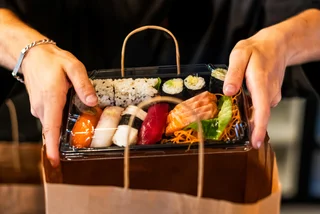The baked goods section of a supermarket or the local bakery may be a little bewildering at first. What do the various loaves contain? And how do they differ? We’ve prepared this guide of some of the more common varieties and places to get international bread.
Bread Loaves
Konzumní or šumavský is the typical loaf which you’ll find in most supermarkets and bakeries. It is oval, with a golden brown chewy crust and light brown inside. It contains about 70% wheat flour and 30% rye flour. The crust is chewy and the inside spongy, a little moist and light brown. In some cases, šumavský is dusted with flour on top. Occasionally, šumavský loaves are smaller than konzumní . Basically, when you ask for bread in bakery, this is what you get.
Držkovský is a variation on the standard Czech bread. It is also oval with a copper-brown crust. The crust is shinier than most other breads and it has a dusting of flour on the underside. It is also chewier and denser than other breads. The name derives from Držkov, a small town in the Liberec region.
Maďarský – in English, Hungarian – looks quite similar to šumavský, though sometimes it is sold in circular loaves. It contains a type of whole grain, roughly ground flour called ‘grahamová mouka’ (Graham’s flour). Who Graham was and why he deserved having a flour named after him is anybody’s guess.
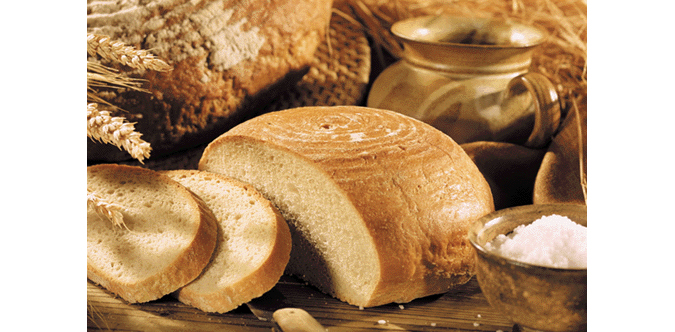
Hostivařský comes in large circular loaves with a hard crust, topped with caraway seeds. The inside is quite dense and spongy with more cumin seeds.
Slunečnicový contains sunflower seeds, hence the name. (Slunečnice is the Czech for sunflower.) The seeds are also baked on top, making it easy to distinguish. If you’re fond of sunflower seeds, you can’t go wrong with this bread.
Dýňový is pumpkin bread, made from pumpkin seeds.
Toasting and Topinky
Because the denser nature of Czech bread, it doesn’t toast as quick or as well as traditional sandwich bread. However, if you’re not too health conscious, you can make topinky – fried bread – with your old bread. Traditionally, it’s eaten with garlic rubbed onto one side.
Bread Rolls
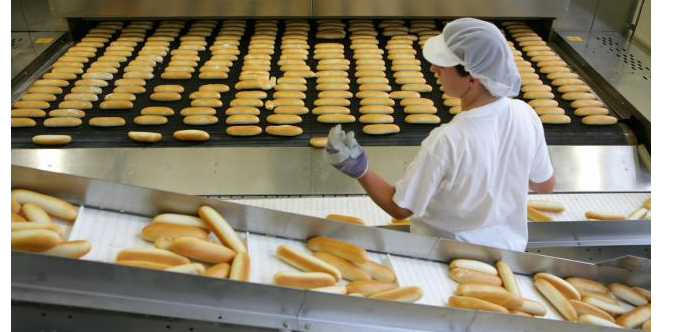
Rohlík is your common roll, available by the crate load and often used to pacify children in supermarkets. The ones in supermarkets tend to be soft on the outside. Bakeries offer crispier versions. Sometimes they come in the shape of a crescent. They can be topped with caraway or poppy seeds on top. Wholegrain and multi-grain rohliks are also available. They are often used as a hotdog roll.
Pivní Rohlík is the rohlík’s longer, thinner cousin. Sea salt is often baked on top. Traditionally, it is eaten with beer, hence the name. It can also make a more savoury accompaniment to soup.
Houska is the other common bread roll. It is baked into squat braids. A good houska is crispy on the outside and spongy and light within. Often they are topped with poppy seeds or sea salt. Supermarkets will sometimes sell houska which have a similar taste and texture to their rohlíky.
Pletýnka, literally little braid or plat, looks like a large houska. The similarities end there. The crust is crispier and the inside light and chewy. Because of its size, it’s good for sandwiches.
Bulka is perhaps the plainest-looking bun; it looks a little like a dinner roll. They can be made from a mix of rye and wheat, and so have a slightly crunchier crust. You may also see them used as the buns for fried cheese or hamburgers, though the ones at most food stalls tend to be dry and not as crispy.
Žemle is a small bun. It can be white, whole grain, or multigrain. Often they have a crease running down the center, making them easy to pull apart. Žemle at food stalls are often of a much lower quality.
Kaiserka means little kaiser, or emperor. This bun is small and circular, with a star pattern on the top. White, wholegrain and multi-grain are available. Sometimes they are topped with poppy seeds.
Toast is the local term for sliced sandwich bread. The quality of local varieties has improved, but it still remains less springy than the bread from the UK or US.
Bageta must be baguette. Purists may reject the local varieties, but the ones from the larger supermarkets, which are baked on site, are quite good. The quality of baguettes from local bakeries is not always reliable. Sometimes they’re too thick, or the crust is not crunchy enough.
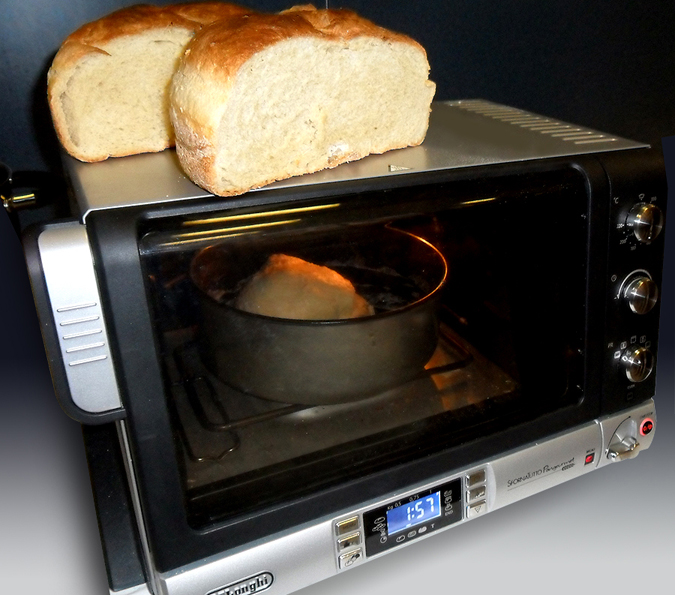
With the De’Longhi Pangourment oven, even you yourself can become a baker!
Key words for bread ingredients
Bread type doesn’t always tell you everything you need to know about bread. Sometimes you need to read the ingredients. Here are some of the key words for bread:
Wheat flour – Pšeničná mouka
Rye Flour – Žitná mouka
Yeast – Kvasnice*
Caraway – Kmín (adjective – kmínový)
Poppy seed – Mák (adjective – makový)
Mutligrain – Vícezrnný
Wholegrain/wholemeal – Celozrnný / cerealní
Gluten – Lepek
Gluten-free – Bezlepkový
Sliced – Krájený
*Yeast can also be translated as droždí, but this word is not often used on the packets.
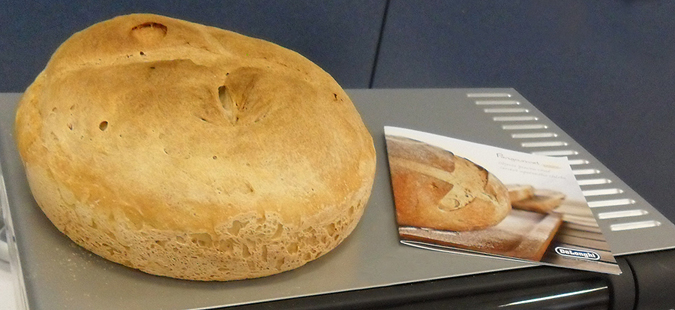
For a recipe for De’longhi white bread click here.
For more baker tips click see http://pangourmet.delonghi.com/en/baker-tips
In the Bakery
Before we enter, you might be wondering what the difference is between pekařství and pekárna. Historically speaking, the former is the shop and the latter is where the bread is made. In reality, you’ll find that the term is used somewhat interchangeably. However, if you’re in a supermarket and you see “z naší pekárny“ it means that the bread was baked there on the premises.
Okay, you’re in the pekářství or pekárna. If you ask for bread (chléb, but most people say chleba), you’ll get the aforementioned konzumní. In some bakeries, they might ask if you want light (světlý) or dark (tmavý). With rolls, they might ask if you want it with salt on top (s soli) or poppy seeds (s mákem). Plain is čistý or bez soli/máku (without salt/poppy seeds). You can also buy half a loaf (půlka) or a quarter (čtvrt).
Freshness and Taste
Quality varies among the bread sold bakeries and supermarkets. If you’ve been put off by one source, try others. Also, there is a huge difference between the sliced packaged version of Czech bread and the fresh whole loaves. The sliced loaves are often drier. Czech bread is at its best in a whole loaf.
International Bakeries and Bread Shops
It’s understandable that from time to time you want more than just the local bread. Here are some Prague shops selling international bread.
Mansson, Bílkova 8 bake a wide range of goods from Scandinavian breads to olive bread and many more. It has received favorable reviews.
Bakeshop, Kozí 1, in Old Town, sell a range of sourdough breads, along with bagels and baguettes. You can read reviews here.
Paul, the French boulangerie, has several locations around Prague. Obviously, they’re the place for baguettes, but you will also find organic bread, dark bread, rye bread, and Flemish bread.
Au Gourmandat Rytířská 22, Praha 1 are another place to go for baguettes. They also bake ciabatta, potato bread, and olive bread.
Wine and Food Market at Strakonická 1, Praha 5 is the place to go for a wide range of Italian breads.
Hopefully, we’ve helped you use your loaf to find your loaf.
Rohlík or houska? What’s your favorite Czech bakery product?
Related articles
- Farewell Fake Rum? A Short History of the Endangered Czech Spirit
- Cocktail Emporium with Prague-Themed Drinks Opens on Wenceslas Square
- Prague Named among Top 10 Vegan-Friendly Capitals In 2017
- Czech Republic Will Continue to Fight Inferior Food Quality
- Take a Look Inside Prague’s New Temple For Meat Lovers












 Reading time: 6 minutes
Reading time: 6 minutes 






















